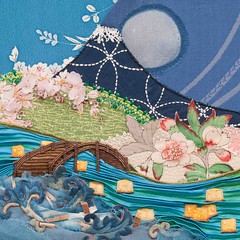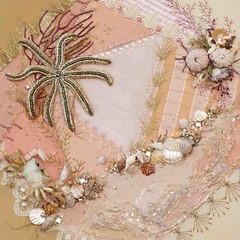I am so fortunate to own this book which was written and illustrated in 1908. It's a real treasure and it gives wonderful information about japanese flowers and gardens. So to continue with a discussion of Japanese gardens, I thought I would share some of the gorgeous illustrations from this book...

 Buddhist traditions which were transmitted to Japan through India and China hold that the lotus is a sacred flower and the symbol of purity. The lotus is also associated with transformation in buddhist heaven where new souls in paradise appear seated on lotuses. Additionally, the bridge often plays an important role in Japanese art and signifies the joining of this worldly life and the afterlife.
Buddhist traditions which were transmitted to Japan through India and China hold that the lotus is a sacred flower and the symbol of purity. The lotus is also associated with transformation in buddhist heaven where new souls in paradise appear seated on lotuses. Additionally, the bridge often plays an important role in Japanese art and signifies the joining of this worldly life and the afterlife.
 I've spoken of the iris before, symbolising strength, wisdom and a fighting spirit. The spoken word in Japanese for iris (shobu) means success as well, though the written characters are different.
I've spoken of the iris before, symbolising strength, wisdom and a fighting spirit. The spoken word in Japanese for iris (shobu) means success as well, though the written characters are different. Because it's an evergreen, the pine tree (matsu) symbolizes longevity, good fortune and steadfastness.
Because it's an evergreen, the pine tree (matsu) symbolizes longevity, good fortune and steadfastness.Because of these auspicious associations, ...Japanese art treats the pine in three primary ways:
- As among those plants that are considered virtuous.
- As a symbol of both winter and the New Year.
- As a premier symbol of long life and even immortality.

 This quote as well as more information about many japanese symbols may be found in this book. It's a beautiful reference book for anyone interested in unlocking the meaning behind Japanese symbolism
This quote as well as more information about many japanese symbols may be found in this book. It's a beautiful reference book for anyone interested in unlocking the meaning behind Japanese symbolism





















1 comment:
Thanks for explaining a few of the symbols.
I've seen a million pics of the stylized gardens - but I thought it was a style, and not symbolic.
Bridge between life and the afterlife.
Aha!
Post a Comment